The Wild Animal Show: A Fascinating Exploration


Nature Topic Overview
The world of wild animal shows embodies a unique intersection between education and entertainment. These events can captivate audiences of all ages, drawing in children who giggle at elephants performing tricks while also instilling appreciation for nature's wonders. Wild animal shows are often organized in zoos, conservation centers, and theme parks, and they showcase a range of species from majestic lions to acrobatic parrots. While the sheer spectacle is enough to attract attention, beneath the surface lies a wealth of knowledge waiting to be uncovered.
The Value of Education in Animal Shows
Wild animal shows are not merely about astounding performances. They serve a dual purpose—as a source of entertainment while also delivering educational insights about wildlife. Trainers often share fun and interesting facts about the animals, informing audiences about their natural backgrounds, behaviors, and even conservation statuses. For example, attendees might learn that a Siberian tiger has a roar that can be heard up to two miles away and that they are critically endangered. This blend of education can be particularly beneficial for young children, nurturing curiosity and motivating preservation efforts.
Fun Facts and Trivia
Here are some fascinating bits about wild animal shows that kids will love:
- The largest living species of tortoise can weigh more than 500 pounds! Imagine that—some turtles are heavier than your bike.
- Did you know that dolphins can recognize themselves in mirrors? They have a high level of intelligence that rivals even some primates.
- Certain types of birds, like parrots, can live for more than 60 years, making them lifelong companions.
For an engaging experience, consider incorporating visuals or interactive elements such as:
- Animal Bingo: Create a bingo sheet with different animals seen at shows. Kids can check them off as they learn.
- Photo Puzzles: Use pictures from the shows to create fun puzzles that help reinforce learning about animals.
Wildlife Explorations
When attending a wild animal show, viewers may encounter various species that they might not see in their daily lives. Each species brings its own quirks and facts that can be both surprising and delightful.
- African Elephants: Known for their large ears and tusks, African elephants can recognize family members even after many years apart.
- Red-tailed Hawks: These birds of prey are excellent hunters, often using their keen sight to locate small animals from great heights.
Some habitats to explore, including:
- Deserts, home to reptiles like the rattlesnake and the iguana
- Rainforests where colorful species like macaws and tree frogs thrive
Interactive features can enhance children’s experiences, such as engaging quizzes about animals they just learned about, or puzzles that require matching animals to their respective habitats.
Environmental Awareness
The importance of conservation in the context of wild animal shows cannot be overstated. By showcasing animals, these shows often bring attention to threats faced by wildlife, sparking discussions on sustainability. It is critical for young audiences to understand:
- Deforestation: Which threatens animal habitats worldwide
- Pollution: How waste affects ecosystems
- Poaching: The illegal practice of hunting endangered species
Kids can contribute to conservation efforts by:
- Adopting a Habit: Small actions like recycling or using less plastic can help
- School Projects: Encouraging friends to join in earth-friendly activities such as planting trees
DIY Nature Activities
Hands-on activities can lead to deeper understanding and appreciation of wildlife. For example, one can:
- Create a Nature Journal: Write down observations after attending a wild animal show, drawing sketches of favorite animals.
- Animal Masks Craft: Using materials at home, create masks of wild animals learned about, discussing their unique traits.
A simple outdoor exploration idea is to go on a nature walk, observing and identifying different species of plants and animals while encouraging children to connect what they see to what they learned at wild animal shows.
With the right blend of fascination and education, wild animal shows can be a gateway to a lifelong appreciation for the natural world. Through actively engaging in these activities, not only do children learn but they also grow into informed advocates for wildlife conservation.
Understanding Wild Animal Shows
When we talk about wild animal shows, we step into a world that draws attention and sometimes raises eyebrows. Understanding these shows is crucial, not just from an entertainment standpoint but also for the insight they provide into wildlife and their habitats. Wild animal shows can serve as a bridge between the wild and human society, showcasing the beauty and diversity of animal life.
These events often seek to educate, inspire, and create awareness about various species. They can open the eyes of children and adults alike, urging them to appreciate animal behavior, habitats, and the need for conservation efforts. Moreover, the nuances of animal behavior portrayed in these shows can and must stimulate conversations about ethical treatment, making it a topic that needs careful thought and consideration.
Definition and Purpose
To dive deeper, we should clarify what we mean by wild animal shows. At their core, these are demonstrations intended to entertain or educate the public about wildlife. Their purpose ranges from creating awareness about endangered species, showing how animals adapt to their surroundings, to encouraging respect for wildlife. This sort of entertainment comes layered with a sense of responsibility.
Types of Wild Animal Shows
Understanding the different formats of wild animal shows is essential for grasping their roles in education and conservation. These shows can be categorized broadly into three main types:
Live demonstration shows
Live demonstration shows stand out because they bring animals physically into the limelight, allowing audiences to witness behaviors firsthand. For instance, a lion's leap or an eagle's swoop can create lasting impressions. These shows are often dynamic and engaging, fostering a sense of awe.
However, spectacular displays can be a double-edged sword. While the thrill can spark interest in wildlife, there's a fine line between entertainment and ethical treatment. Critics argue that these shows risk prioritizing spectacle over animal welfare. Thus, it’s crucial that these demonstrations come with a serious commitment to humane practices and safety standards.
Educational presentations
On the other hand, educational presentations focus more on informative aspects than thrills. They often include professionals discussing wildlife conservation efforts, showcasing animal biology, and emphasizing the importance of preserving natural habitats.
The key characteristic here is its informative nature, often backed by facts and interactive Q&A sessions. Educational presentations help children and adults create connections with wildlife in thoughtful ways. A potential downside, however, could be that they sometimes lack the excitement that captivates the younger audience’s attention.
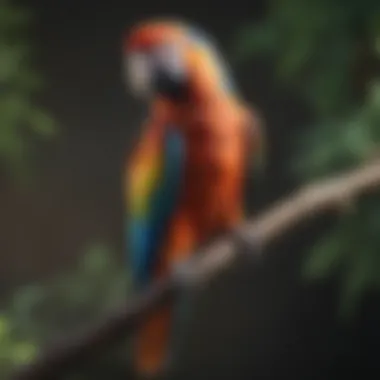

Documentary-style exhibitions
Documentary-style exhibitions create immersive experiences that educate viewers about specific species or ecosystems. They often include high-quality videos combined with expert commentary, allowing viewers to understand the lives of animals in their natural habitats.
These exhibitions shine in their storytelling ability. They portray the struggles and triumphs of wildlife, giving context to conservation efforts. However, as amazing as these experiences can be, they may not always have the same immediate impact that seeing animals live or engaging in interactive formats can provide.
"Every image, sound, and interaction has the power to leave a mark or even inspire a lifelong commitment to wildlife preservation."
By dissecting these types of shows, we grasp the diverse approaches taken to portray wildlife. This understanding is crucial for fostering a culture that respects and protects our planet's biodiversity.
Species Featured in Wild Animal Shows
The species that grace wild animal shows play a critical role in shaping how audiences perceive wildlife. It’s essential to feature animals that not only capture attention but also educate viewers about the vital role these creatures play in their ecosystems. Through showcasing the right species, organizers aim to cultivate an appreciation for wildlife, wrapped up with a necessary understanding of conservation.
Common Mammals
Lions and Tigers
When it comes to wild animal shows, lions and tigers often take center stage. These big cats are not just visually stunning; they also symbolize power and grace. Their majestic presence enchants audiences, and they easily become crowd favorites. One key characteristic of these animals is their social behavior, especially in lions, which allows for engaging demonstrations that can illustrate complex social structures.
However, a unique feature of lions and tigers lies in their conservation status. They are often used in educational contexts to highlight the issues facing their populations in the wild, such as habitat loss and poaching. While these shows can raise awareness, it’s crucial to ensure the animals are treated with respect and their wellbeing prioritized, which introduces potential challenges regarding training and habitat requirements.
Bears and Wolves
The inclusion of bears and wolves adds another layer to wild animal shows. Bears showcase human-like intelligence and strength, while wolves exhibit intriguing social dynamics within their packs. A characteristic that sets bears apart is their dexterity; they can manipulate objects with surprising skill. This can be showcased creatively to teach children about nature's adaptability.
On the other hand, wolves are often portrayed as symbols of wilderness and community. Their pack mentality provides a fantastic opportunity to talk about teamwork and social structures in the animal kingdom. One unique aspect is their vocalization; different sounds can be used to communicate various messages, which can be a captivating way to engage audiences. Nevertheless, ethical practices in training and exhibiting these animals are paramount to ensure their stress and anxiety are minimized, making their appearance as beneficial as possible.
Birds of Prey
Eagles
Eagles are the embodiment of freedom and power in the avian world. They are commonly featured in shows due to their impressive flight capabilities and keen eyesight. One key characteristic that makes eagles so popular is their ability to soar high, demonstrating remarkable aerial agility that can captivate viewers.
Their visual prowess serves a dual purpose; it not only entertains but also educates. Shows that feature eagles can discuss their vital role in ecosystems, such as controlling populations of smaller animals. However, there are disadvantages too. Eagles require vast spaces to thrive and can get stressed in confined environments, highlighting the need for ethical considerations in shows that include them.
Owls
Owls are another thrilling addition to wildlife presentations, often portrayed as wise creatures. They have the ability to fly silently, a unique feature that raises interest and curiosity. Owls are typically nocturnal, which allows for discussions regarding different adaptations animals have to survive in diverse habitats.
Their incredible hearing and specialized feathers make them engaging subjects to highlight in educational settings. At the same time, their portrayal in shows brings attention to the need for habitat conservation, as many owl species face threats. Nonetheless, it’s crucial to ensure that their needs are met in captivity, as stress can lead to health issues.
Reptiles and Amphibians
Crocodiles
Crocodiles are not just ancient reptiles; they’re living fossils that command respect and curiosity. Their powerful jaws and prehistoric appearance can serve to both scare and amaze audiences. Featuring crocodiles in shows allows for discussions on evolutionary biology, adaptive traits, and conservation, particularly as many species are endangered.
Despite their fascinating characteristics, crocodiles are not easy to exhibit. They require specific care and space, posing challenges for training and presentations. However, when managed well, they can help to educate children about reptiles and the importance of preserving their natural habitats.
Snakes
Featuring snakes in wildlife presentations brings a variety of benefits, particularly their role in controlling pest populations. Snakes have gorgeous and unique patterns and colors that make them visually appealing. Moreover, they can serve as a bridge to discuss the misconceptions surrounding them, often seen as dangerous creatures.
A unique aspect of snakes is their ability to regenerate their skins, an excellent way to speak on the subject of growth and change in nature. However, like other reptiles, their care needs are specific and require knowledgeable handlers to prevent stress and ensure their health.
Frogs
Frogs are often underestimated, but they provide a vital ecological role by acting as indicators of environmental health. Their sensitive skin and varied life stages make them fascinating to explore in educational settings. Frogs can be showcased to illustrate concepts of metamorphosis and the importance of biodiversity.
With their diverse calls and bright colors, frogs catch the eye, yet they too face numerous threats in the wild. Exhibiting frogs can help raise awareness about habitat preservation and the dangers of pollution. Challenges may arise in maintaining the suitable environment for live demonstrations, which must be meticulously managed.
The Training and Care of Wild Animals
The nurturing of wild animals plays a crucial role in the realm of wild animal shows. It’s more than just a backdrop to the excitement; it’s foundational to the animal’s health and their training effectiveness. Here, the focus shifts to the techniques employed for training and the daily routines that keep these magnificent creatures in prime condition. Understanding these elements can cultivate a deeper appreciation for both the animals and the professionals who care for them.
Training Techniques
Positive reinforcement
Positive reinforcement is a method that utilizes rewards to encourage desired behaviors in animals. It's like giving a pat on the back but for critters, making the training process a rewarding experience for them. One of the key characteristics of this approach is its effectiveness; animals tend to repeat behaviors that bring them pleasure. This technique not only enhances the animal’s learning but significantly strengthens the bond between the creature and its trainer.
A unique feature of positive reinforcement is the flexibility it offers. Trainers can tailor rewards—such as treats, playtime, or praise—based on what motivates each animal. This adaptability not only keeps training sessions engaging but also increases the efficiency of learning. However, it has its downsides; without the right balance, animals may become reliant on rewards, which can hinder their ability to perform tasks without them.
Desensitization methods
Desensitization methods aim to reduce fear and anxiety in wild animals, which is vital, especially when they're exposed to unfamiliar environments or situations. A pivotal quality of this technique is its gradual approach— by systematically introducing animals to stimuli that might make them uneasy, trainers can help the animal adjust without overwhelming it. This can be particularly beneficial in wild animal shows, where loud noises and crowds are common.
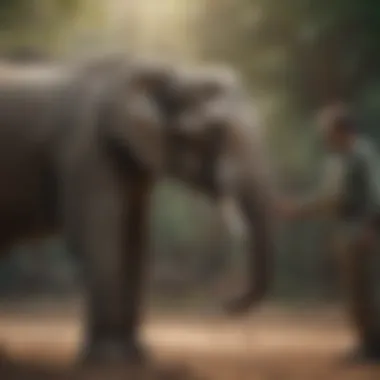
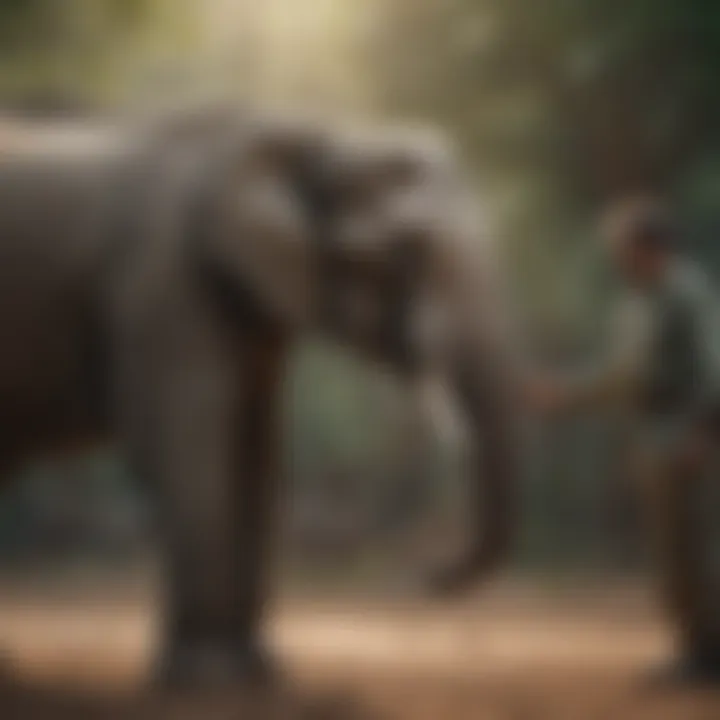
The most distinctive feature of desensitization is its focus on exposure. Trainers often utilize a series of controlled experiences, gradually intensifying the stimuli. This humane approach allows animals to build confidence over time. However, it may require patience and can take longer to see tangible results compared to other methods. Balancing this patience with the animal's well-being is essential in ensuring effective training outcomes.
Daily Care Routines
Feeding practices
Feeding practices are essential not only for the physical health of wild animals but also for their overall well-being. The key characteristic here is the individualized diet plans that cater to the specific nutritional needs of each species. This tailored approach ensures that animals receive all necessary nutrients while maintaining their health and vigor.
A standout feature of effective feeding routines is the emphasis on both quantity and quality of food. Wild animal shows strive to source high-quality ingredients, taking into account the animals’ natural diets. The disadvantages, however, can stem from the complexities of preparing these specialized diets, which can be time-consuming and require careful planning to avoid nutritional deficiencies.
Health monitoring
Health monitoring is an integral part of daily care routines in wild animal shows. This process is all about keeping a sharp eye on the physiological and psychological well-being of the animals. The main characteristic that sets this practice apart is its proactive nature—it’s not just about fixing issues as they arise but identifying them early on.
Unique features of health monitoring include regular check-ups, detailed health records, and behavioral assessments. These steps are vital for early detection of potential problems. The downside, though, maybe the resource investment required, including staff training and potentially high vet costs, which can be a strain on logistical budgets. Nonetheless, the benefits of ensuring all animals stay healthy and thriving far outweigh these challenges.
The training and care of wild animals is not just an art; it's a science that ensures both the welfare of the animals and the success of the shows.
With a focus on both effective training techniques and diligent daily care practices, we can foster a setting where wild animals not only live but thrive, ultimately enhancing their contributions to wild animal shows and the rich tapestry of wildlife appreciation.
Educational Value for Children
When we talk about wild animal shows, we often think of entertainment and excitement. However, there’s a deeper purpose that these shows fulfill, especially when it comes to children. By engaging young minds, these exhibitions aim to impart lessons about the natural world that are crucial for developing a sense of responsibility and connection to wildlife.
One of the core benefits of wild animal shows is their ability to promote wildlife awareness. Children, while often captivated by the charm of lions, tigers, or playful otters, also absorb vital information about these animals—their habitats, behaviors, and roles in the ecosystem. This connection can foster a lifetime interest in wildlife and nature. Kids who attend these shows may find themselves asking questions like "Why do we need to protect these animals?" or "What can I do to help?", opening the door for learning that extends beyond the show itself.
Moreover, wild animal shows act as a springboard for encouraging conservation efforts among the younger generation. Through interactive sessions and engaging displays, these shows often highlight the threats faced by various species, such as habitat loss, poaching, and climate change. Understanding these challenges is the first step towards cultivating a sense of urgency to act. Kids who feel a connection to an animal are more likely to advocate for its protection. Programs that promote recycling or habitat preservation can be tied back to the stories of animals they’ve seen.
Effectively, these shows are not just about letting kids see animals up close; they're about shaping future citizens who can think critically about the environment and participate in solutions that can lead to a healthier planet.
"Every child who sees a tiger or a parrot at a wild animal show can become a champion for the wildlife they adore. Education sparks conservation."
In addition, educational components are often woven through every aspect of the show. Many presentations include engaging facts and interactive quizzes that help solidify knowledge. This approach not only enhances retention but also makes learning fun. To encourage parents and educators to utilize these experiences, suggestions can be made on how to further discuss what they've learned at home or in the classroom, creating a multi-faceted educational approach.
Ultimately, the educational value inherent in wild animal shows is multifaceted, reaching far beyond simple entertainment. They promote awareness and inspire young individuals to engage with conservation efforts, providing them the tools to become proactive stewards of the Earth’s biodiversity.
Promoting Wildlife Awareness
Wild animal shows play a significant role in nurturing an appreciation for nature among children. When kids are exposed to magnificent creatures like elephants or leopards, it's often a moment of wonder. This wonder can be translated into a passion for animals and wildlife. When they learn about animal tracks, sounds, and behaviors in an entertaining setting, the information sticks better than in a classroom.
There are various techniques employed during these shows to captivate children's interests:
- Engagement through storytelling: Presenters often incorporate stories about individual animals, their journeys, and challenges, making the animals relatable.
- Interactive demonstrations: Allowing kids to participate or ask questions about the animals reinforces their learning.
- Visual aids: Stunning visuals and videos help illustrate the importance of habitats and conservation efforts.
Promoting wildlife awareness can lead to discussions at home about animals, ecosystems, and why these matters are essential. Parents and kids might find themselves visiting local zoos or wildlife parks to further explore these topics.
Encouraging Conservation Efforts
Encouraging conservation efforts is another fundamental aspect that stems directly from wild animal shows. When children learn about the fragile state of wildlife and the threats they face, it ignites a spark of activism within them, even at a young age.
This promotion takes different forms, including:
- Fundraising initiatives: Many shows often partner with conservation organizations, inspiring children to participate in fundraising for these crucial projects.
- Community programs: Kids can get involved in local cleanups, tree planting, or wildlife monitoring, directly putting into action what they've learned.
- Educational materials: Handouts or follow-up activities provided at the end of the show can reinforce learning and inspire further exploration.
In a nutshell, programs designed for children through wild animal shows not only educate but empower. They craft knowledgeable young minds that may one day take up the mantle of conservationists, ready to advocate for the animals they once gazed upon in awe. Educating through engagement is the key to fostering a generation dedicated to preserving the wonders of the natural world.
Ethical Considerations in Wild Animal Shows
The conversation surrounding wild animal shows is just as lively as the creatures they showcase. As we examine these captivating displays, it’s vital to understand the ethical considerations at play. This section sheds light on how these shows impact not just the animals involved but also the audience, especially young minds soaking in every vibrant moment.
Animal Welfare Concerns
Animal welfare is the crux of the ethical debate in wild animal shows. Many people raise their eyebrows at the idea of wild animals in captivity, fearing for their physical and mental well-being. The conditions in which these animals are kept vary tremendously from one facility to another, which is a point of concern.
Ensuring proper habitats that mimic their natural environments is crucial. A lion, for instance, wouldn't thrive in a cramped enclosure; that’s like trying to fit a square peg in a round hole. Keeping animals stimulated and healthy is not just kind; it’s essential for their well-being.
"Animals not only display physical prowess; they also reveal their mental states through behavior. It’s our job to ensure that they can express themselves adequately."
Moreover, it’s essential to consider the training techniques used. If the trainers rely solely on positive reinforcement—rewarding desired behaviors rather than punishing undesired ones—the chances of maintaining good animal welfare increase significantly. This allows animals to develop a bond of trust, perhaps leading to performances that don’t compromise their dignity.
Regulations and Standards
The ethical considerations around animal shows don’t stop at welfare—regulations and standards play a monumental role. Knowing what governs these shows at various levels helps understand the protections in place for these magnificent creatures.
Local regulations
Local regulations aim to ensure that animal shows operate within certain bounds. These rules often include guidelines on the size of enclosures, the conditions in which animals are displayed, and how they are trained. For example, many localities require permits or licenses for facilities housing wild animals. This oversight is meant to create a baseline for care standards.
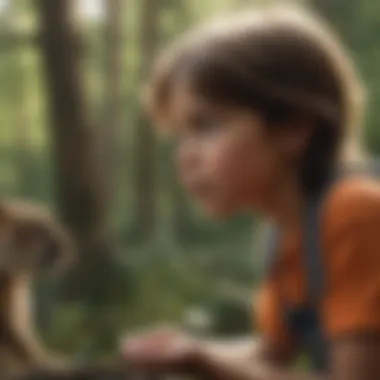
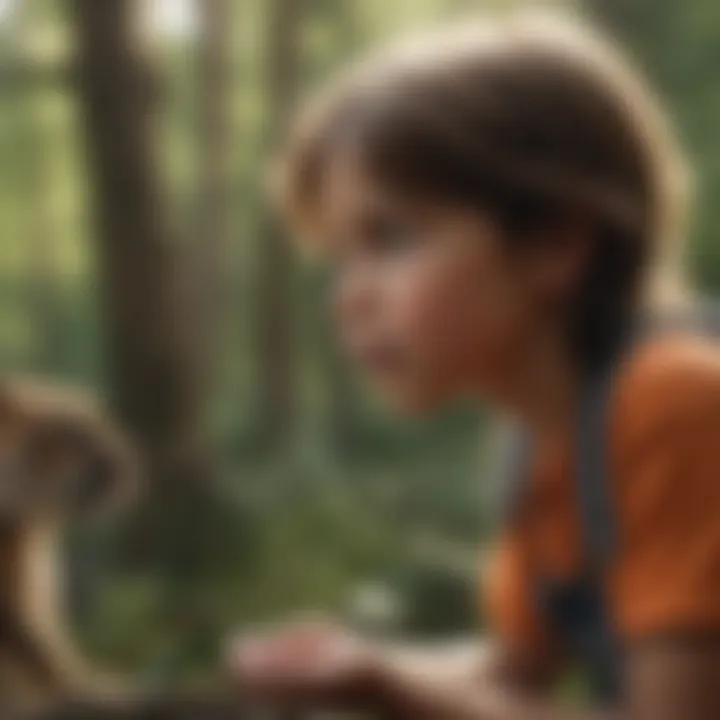
The primary benefit of local regulations is that they are tailored to the specific environments and community standards of an area. A zoo in Florida might operate under different rules than one in California, reflecting regional considerations like climate and the types of species present. However, one downside can be inconsistency; not all communities may prioritize animal welfare equally.
International laws
On a broader scale, international laws come into play, setting standards that transcend national boundaries. These agreements, like the Convention on International Trade in Endangered Species of Wild Fauna and Flora (CITES), work to protect threatened species globally. It assures viewing wildlife in a responsible manner, minimizing risks associated with exploitation.
One critical aspect of international laws is their ability to create a unified approach to conservation and animal welfare. They help promote ethical wildlife shows worldwide, fostering respect and care on a global stage. However, enforcement can be a bit of a sticky wicket, as varying political climates and levels of commitment to conservation can affect implementation.
Overall, it's a real balancing act between providing entertainment and maintaining ethical standards. Wild animal shows have the potential to educate and inspire awe for nature, but the approach must always prioritize the welfare of the animals involved.
Impact of Wild Animal Shows on Conservation
Wild animal shows serve more than just entertainment; they hold significant potential in the realm of conservation. By presenting compelling narratives around various species, these shows can ignite a sense of urgency and passion for protecting the natural world. Many people, especially children, often have their first encounters with exotic animals through these exhibits. This exposure can shape their outlook on wildlife, steering them towards becoming advocates for the very creatures they witness.
Fundraising for Conservation Projects
A notable benefit of wild animal shows is their role in raising money for conservation efforts. Ticket sales from these shows can directly fund projects focused on wildlife preservation. For instance, zoos and sanctuaries often allocate a portion of their revenue from shows to support initiatives like habitat restoration or breeding programs for endangered species.
- Educational Campaigns: Shows often use part of their proceeds to educate the public about endangered animals, driving contributions to organizations that work toward their protection.
- Community Involvement: Through events that incorporate local wildlife, community members are encouraged to participate, fostering a sense of ownership and responsibility toward conservation efforts.
More than just a way to keep the audience entertained, these shows can create a lasting impact on the purse strings for conservation causes. They allow organizations to bridge the gap between entertainment and philanthropy, ensuring that wildlife isn’t just a thing of the past but a living, breathing part of our future.
Inspiring Future Conservationists
The wonder of seeing a majestic lion or an elegant eagle in action is akin to flipping a switch in a child’s mind. Wild animal shows can be the spark that ignites a lifelong passion for wildlife conservation among younger audiences. They introduce children to the sheer beauty and diversity of life on our planet, often resulting in a newfound appreciation for species that they may only know from books or screens.
Here are some ways these shows help cultivate future conservationists:
- Role Models: Presenters who are passionate about animals can become role models, demonstrating the importance of respect and care for all living creatures.
- Hands-On Learning: Some shows offer interactive experiences, allowing children to engage directly with animals under safe, supervised conditions, fostering a deeper understanding of wildlife.
- Awareness: Discussions during the shows highlight real-world issues like habitat loss, poaching, and climate change, planting the seeds of advocacy early on.
"Children today are the guardians of tomorrow's biodiversity. Every wild animal show has the potential to enthuse a new generation of conservationists."
A Comprehensive Look at the Future of Wild Animal Shows
As we peer into the future of wild animal shows, it becomes increasingly clear that their role in education and conservation is not only vital, but also evolving. These shows, which have captivated audiences for generations, are at a crossroads, shaped by advancements in technology and shifting societal perspectives. Recognizing the narrative of these developments helps us navigate the landscape of wildlife presentation more effectively.
Trends in Wildlife Presentation
Technology Integration
Integrating technology into wild animal shows has been nothing short of revolutionary. Think about it: the addition of augmented reality and interactive displays makes it possible for viewers to experience wildlife in ways that were unthinkable a few decades ago. One particular characteristic is the use of virtual reality headsets, which allows children and adults alike to "step into" the animal’s world. This immersive experience captivates attention and fosters a deeper connection to wildlife.
The unique feature of technology integration lies in its ability to transform traditional presentations into dynamic experiences. For instance, live feeds or cameras positioned in an animal's natural habitat provide the audience a glimpse of their behaviors without disrupting their environment. This is not just a fad; it’s a growing demand for more engaging educational content.
While the advantages are numerous, such as increased audience engagement and richer educational content, there are downsides too. Over-reliance on technology could detract from the primary goal of instilling a sense of respect and appreciation for wildlife. Hence, finding the right balance is essential in maximizing the benefits of technology while safeguarding the core mission of wildlife education.
Virtual Experiences
Virtual experiences have also gained traction, especially in the wake of global events that limited physical interactions. These online presentations allow participants to join wild animal shows from the comfort of their homes, making them accessible to wider audiences. The standout characteristic of virtual experiences is their flexibility; for example, a family in a rural area can attend a show that they’d otherwise have no chance of experiencing in person.
The essence of virtual experiences is their potential to break geographical barriers and create inclusive environments where people from diverse backgrounds can connect over a shared interest in wildlife. A noteworthy feature is the opportunity for interactive Q&A sessions with animal experts, enabling children to nurture curiosity.
However, virtual experiences also come with considerations. The absence of a physical presence might lessen the impact of witnessing a wild animal up close. Moreover, the challenge of keeping young attention spans focused on screens is always present. Hence, while virtual shows promise to broaden access and participation, they should complement rather than replace the traditional form of engagement.
Shifting Perspectives Toward Education
Finally, as society becomes more attuned to wildlife issues, the focus on educational value in wild animal shows is becoming paramount. The approach has shifted from mere entertainment to a more comprehensive educational experience that promotes empathy, respect, and understanding of wildlife conservation. Educators, parents, and organizations increasingly advocate for these venues to serve as catalysts for teaching children about biodiversity and ecological interconnectivity.
Understanding animals should not solely stem from curiosity, but rather an inherent sense of responsibility towards their protection. Programs that include hands-on interactions, storytelling, and impactful messaging around conservation efforts can pack quite the punch in shaping future conservationists.
"Our future depends not just on viewing wildlife, but understanding what it means to be stewards of their world."
As the future unfolds, the landscape of wild animal shows will likely shift in unexpected directions. By paying heed to technological advancements and societal expectations, stakeholders can craft shows that not only entertain but also enlighten. It's about engaging the next generation, encouraging them to become part of wildlife conservation in their day-to-day lives. With this understanding, we can strive for a future where wild animal shows are more than a spectacle; they evolve into essential educational experiences that inspire action.
Culmination
When wrapping up our exploration of wild animal shows, it’s crucial to ponder the significance they hold in our world today. The intricate balance between entertainment and education is a key element in fostering a genuine appreciation for wildlife among audiences of all ages. Children, in particular, benefit immensely from these experiences, as they can develop an early understanding of the importance of conservation efforts, and this sets the stage for a lifetime of respect towards animals and nature.
Summarizing Insights
As we reflect on the many facets of wild animal shows discussed throughout this article, the educational value emerges as a fundamental pillar. Wild animal shows not only serve as a source of entertainment but offer rich insights into the behaviors, habitats, and needs of the various species featured. Children can see majestic lions, playful otters, and soaring eagles up close, sparking curiosity and igniting imaginations. The interactive nature of these shows keeps young minds engaged, allowing them to absorb vital information in a fun and stimulating way.
Moreover, the ethical considerations surrounding these events cannot be dismissed. They invite us to challenge our perspectives on animal welfare and conservation. It's essential for parents and educators to engage children in discussions about these elements, guiding them to understand the value of compassion and responsibility. Wild animal shows can be catalysts for conversations that shape attitudes and inspire action toward wildlife preservation.
The Road Ahead
Looking ahead, the future of wild animal shows appears bright, albeit with necessary transitions. There's an ongoing trend towards more ethics-focused displays, further emphasizing animal welfare without compromising educational value. As technology bleeds into the ecosystem of wildlife presentations, we are beginning to see virtual reality experiences that transport viewers to the wild. These advancements allow for immersive learning, helping kids to grasp the vastness of our planet’s ecosystems while still prioritizing the animals’ natural behaviors.
Additionally, as awareness grows regarding conservation efforts, there is a shift in how we perceive entertainment in relation to wildlife. It's becoming clearer that every show must embrace a dual purpose: to entertain while also educating. The goal, ultimately, is to inspire the next generation of conservationists. Consequently, wild animal shows will need to constantly evolve, adapting to new developments while remaining steadfast in their commitment to educate and protect wildlife for future generations.
"Wildlife must have a place of safety, a chance to thrive in its habitat."
The evolution of wild animal shows alongside a growing understanding of their ethical implications and educational role indicates an optimistic horizon. There’s hope that as these shows adapt, they will cultivate a deeper connection to nature, fostering both respect and a drive for conservation amongst the youth.







